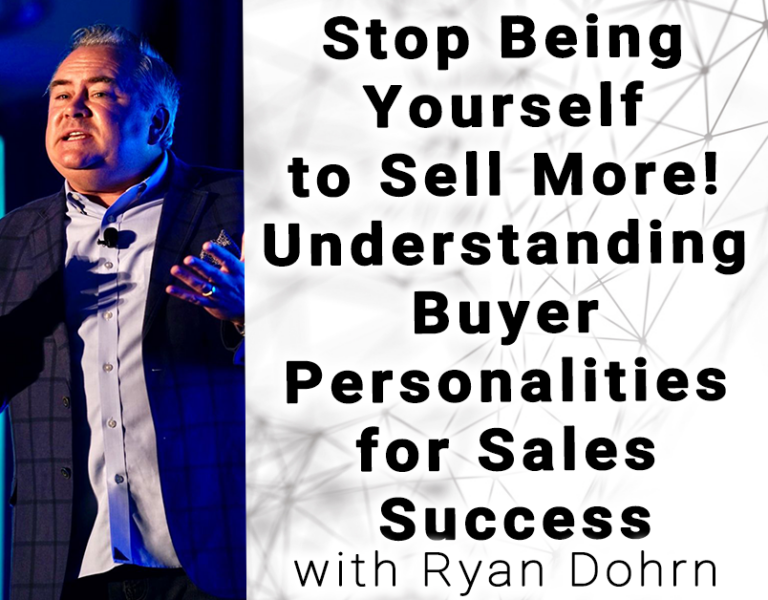
I want to challenge you with a bold idea: Stop being yourself. It might sound strange, but being yourself in sales could be hurting your business. Why? Because your natural selling style might not match the personality of the buyer you’re trying to connect with, and that mismatch could cost you the sale. From an ad sales training perspective, this could be the most important blog you ready this month.
There are three main types of buyers you’ll come across in sales:
- Ego-Driven Buyers
- Logical Buyers
- Emotional Buyers
Most people sell the way they prefer to buy. For example, if you tend to buy things based on logic, you probably sell using facts, data, and logic. But what happens when you’re talking to an emotional buyer? That approach may not resonate, which is why understanding the difference between these buyer types is crucial. The key is to tailor your approach to fit their personality, not just rely on your own style.
Who Are You as a Seller?
Before you can start adapting to different buyers, you need to understand your own selling style. Let me give you a quick example from my experience. If you’re an emotional buyer, you might find yourself drawn to purchases based on how they make you feel. If you’re a logical buyer, you’re probably more focused on facts, figures, and practicality. These same tendencies apply when you’re selling. If you’re selling emotionally but dealing with someone who needs hard data and logic, you’re probably going to lose them. So first, you need to ask: who are you as a seller? Once you know that, you can start adjusting your strategy to meet the needs of different buyer types. If you happen to say that you are a little of both… you are emotional. 😉
Who Are You Selling To?
The next step is figuring out the personality of the buyer you’re meeting. This is where you can get strategic. Research the person you’re selling to—check out their LinkedIn profile or use AI tools to understand their communication style. If you notice they post a lot of lists, structured content, or data-driven insights, you’re likely dealing with a logical buyer. On the other hand, if they share stories, emotional posts, or personal experiences, you’ve got an emotional buyer on your hands. I tell people all the time in my ad sales training workshops, adapting your style to meet the buyer’s needs isn’t about being fake—it’s about being smart.
How Do You Sell to Each Type?
Here’s how you can approach different buyers:
- Logical Buyers: Stick to the facts. Bring data, research, and clear arguments because that’s what resonates with them.
- Emotional Buyers: Lean into storytelling and emotion. Talk about success stories, paint a picture, and use FOMO (fear of missing out) to tap into their emotional decision-making.
- Ego-Driven Buyers: Although they’re less common, these buyers thrive on recognition and validation. Make sure to acknowledge their importance and cater to their sense of achievement.
Be Strategic, Not Fake
When I say, “Don’t be yourself,” I’m not telling you to be dishonest or unethical. What I’m really saying is to be strategic. Shooting from the hip might work once in a while, but if you want consistent success, you need to align your style with the buyer’s personality. It’s about being in tune with who you’re talking to and delivering a pitch that speaks to their mindset, not just yours.
Final Thoughts: Align for Success
When it comes down to it, selling is about more than just ad sales training or presenting your product or service. It’s about aligning yourself with your buyer’s mindset. Remember, who you are as a buyer often shapes who you are as a seller. By strategically adapting your approach, you can create stronger connections and ultimately close more deals. Here’s a quick recap of what to keep in mind:
- Identify your buyer type: Determine if your buyer is ego-driven, logical, or emotional.
- Recognize your own style: Are you an emotional buyer? Logical? Knowing how you buy helps you understand how you naturally sell.
- Do your homework: Research your buyer before a sales meeting. Use LinkedIn and AI tools to uncover if they lean toward a logical or emotional approach.
- Adjust your strategy: Once you know your buyer’s personality, tailor your sales pitch accordingly. Logical buyers need data and facts, while emotional buyers connect with stories and feelings.
- Stay authentic, but adaptable: You don’t need to change who you are. Just be smart about shifting your focus to match your buyer’s needs.
By following these steps, you’ll not only refine your sales process, but you’ll also build a deeper understanding of your clients and create better, long-lasting relationships.
Never forget, friends, if Sales was easy, everybody would be doing it. They are not. We are the chosen few. This is a great job. It’ll feed your family for a lifetime. If you need coaching advice and help or need me to speak to your group and motivate them to sell success, just reach out to me Ryan@RyanDohrn.com.
About this author:
Listen to Ryan’s ad sales podcast, Ad Sales Nation, on iTunes or on Soundcloud. Keep up to date with Ryan’s ad sales training advice on Facebook at: https://www.facebook.com/RyanDohrnLIVE
Ryan Dohrn is an award winning ad sales training coach, a nationally recognized internet sales consultant, and an international motivational speaker. He is the author of the best-selling ad sales book, Selling Backwards. Ryan is the President and founder of Brain Swell Media and 360 Ad Sales Training, a boutique ad sales training and sales coaching firm with a detailed focus on ad sales training, internet consulting, and media revenue generation. Ryan is also the Publisher of Sales Training World.
Contact information:
Ryan R. Dohrn
President/Founder
360 Ad Sales Training and Strategy
Brain Swell Media LLC
Ryan@BrainSwellMedia.com
http://www.BrainSwellMedia.com
http://RyanDohrn.com
http://360adsales.com
http://sellingbackwards.com
http://SalesTrainingWorld.com
http://AdSalesNation.com
Follow him on Twitter.com/ryandohrn for daily tips and advice.
http://www.linkedin.com/in/ryandohrn
